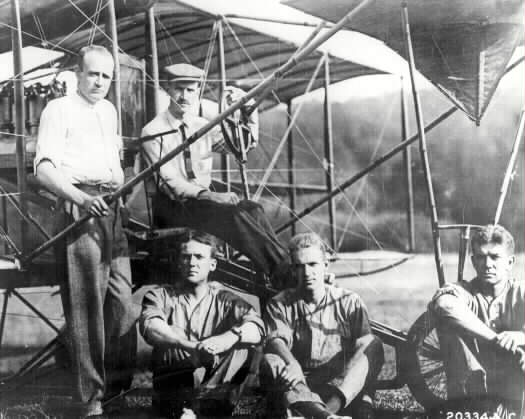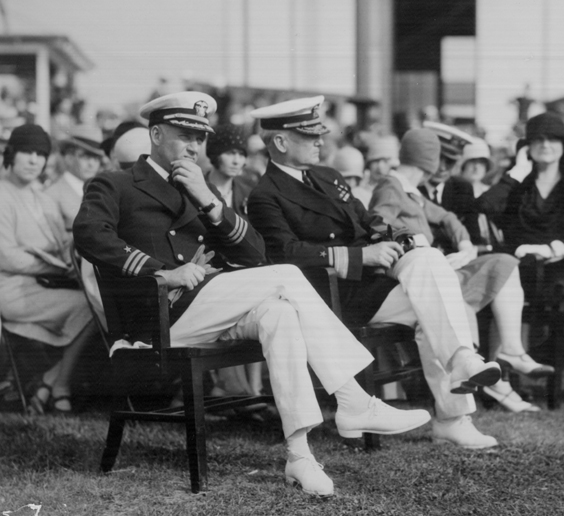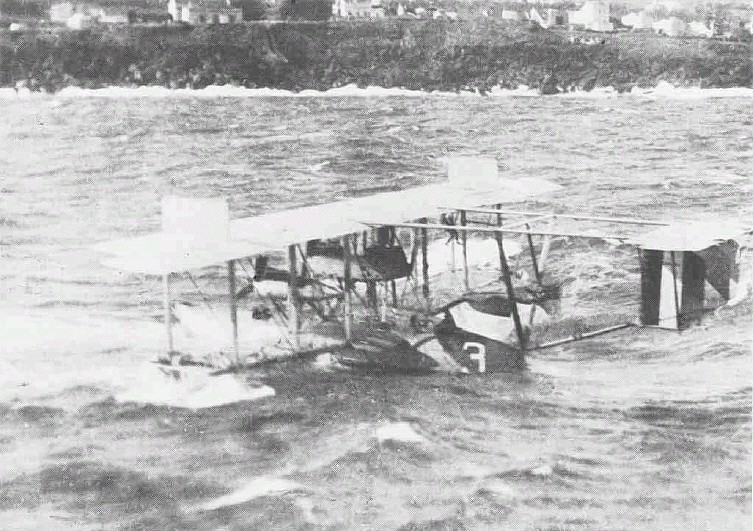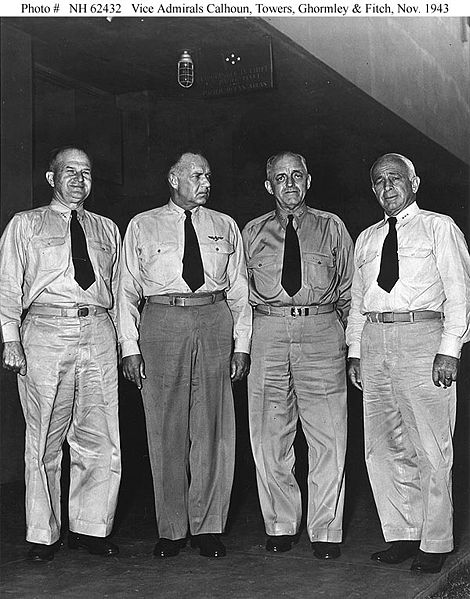<Back to Index>
- Naval Aviator Admiral John Henry Towers, 1885
- Writer Anton Hansen Tammsaare, 1878
- Tsar of Bulgaria Boris III the Unifier, 1894
PAGE SPONSOR
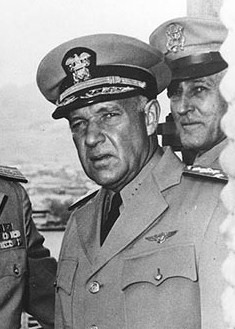
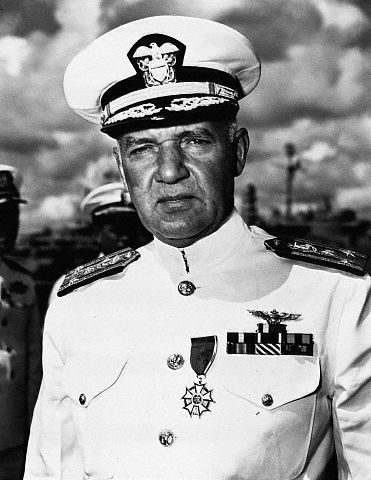

John Henry Towers (January 30, 1885 – April 30, 1955) was a United States Navy admiral and pioneer Naval aviator. He made important contributions to the technical and organizational development of Naval Aviation from its very beginnings, eventually serving as Chief of the Bureau of Aeronautics (1939 – 1942). He commanded carrier task forces during World War II, and retired in December 1947. He was the only one of the early Naval Aviation pioneers to survive the extreme hazards of early flight who remained with naval aviation throughout his career. He was the first naval aviator to achieve flag rank and was the most senior advocate for naval aviation during a time when the Navy was dominated by battleship admirals. Towers spent his last years supporting aeronautical research and advising the aviation industry.
Towers was born on 30 January 1885 at Rome, Georgia. He graduated from the United States Naval Academy in the Class of 1906, and was commissioned ensign in 1908 while serving aboard the battleship USS Kentucky (BB-6). He was later assigned to the battleship USS Michigan (BB-27) before reporting to the Curtiss Flying School in Hammondsport, New York, on June 27, 1911 for aviation training.
Under the tutelage of aviation pioneer Glenn Curtiss and Lieutenant Theodore G. Ellyson, Towers qualified as a pilot in August 1911, flying the Navy's first airplane, a Curtiss A-1 seaplane.
Towers next traveled to North Island in San Diego, California, where, in conjunction with the Curtiss Flying School, he took part in developing and improving naval aircraft types.
In October 1911, Towers achieved a distance record, flying an A-1 from Annapolis, Maryland, to Old Point Comfort, Virginia, a distance of 112 miles, in 122 minutes. In the fall of 1912, Towers supervised the establishment of the Navy's first aviation unit, based at Annapolis. On October 6, 1912, he achieved an American endurance record by rigging extra gasoline tanks to a Curtiss A-2 seaplane, allowing him to remain aloft for 6 hours, ten minutes, 35 seconds. From October to December 1912, Towers conducted tests to spot submerged submarines from the air over the Chesapeake Bay. He furthered those tests into 1913 during fleet operations near Guantanamo Bay, Cuba. Additionally, he investigated the potential for Navy aerial reconnaissance, bombing, photography, and communications.
On 8 May 1913, Lt. Towers flew a long-distance flight of 169 miles in a Curtiss flying boat from the Washington Navy Yard down the Potomac River and then up the Chesapeake Bay to the U.S. Naval Academy at Annapolis, Maryland. The flight took three hours and five minutes. Ensign Godfrey Chevalier was his passenger.
On 20 June 1913, Towers was nearly killed in an aviation mishap over the Chesapeake Bay. While he was flying as a passenger in a Wright seaplane, his plane was caught in a sudden downdraft and plummeted earthward. The pilot, Ensign W.D. Billingsley, was thrown from the aircraft and killed (becoming the first naval aviation fatality). Towers, too, was wrenched from his seat but managed to catch a wing strut and stay with the plane until it crashed into the Chesapeake. Interviewed by Glenn Curtiss soon thereafter, Towers recounted the circumstances of the tragedy; his report and resultant recommendations eventually led to the design and adoption of safety belts and harnesses for pilots and their passengers.
On 20 January 1914, Lieutenant Towers, led 9 officers, 23 men, 7 aircraft, portable hangars, and other gear from the aviation unit at Annapolis, to Pensacola, Fla., to set up the first naval aviation training unit. Then on April 20, 1914, Towers led the first naval aviation unit called into action with the Fleet. He and two other pilots, 12 enlisted men and three aircraft sailed from Pensacola aboard the cruiser Birmingham in response to the Tampico Affair.
In January 1915, the Navy decided to officially designate its flyers. At that time, Towers was officially designated as Naval Aviator No. 3, with an effective date of 1914. Lieutenant Commander Towers, while assigned to the aviation desk under CNO, is credited with the development of the Naval Aviators badge, which were designed and ordered in 1917. On January 19, 1918, distribution of the first gold Naval Aviator wings began, and it is likely that Towers, as Senior Naval Aviator in Washington at the time, was an early, if not the earliest, recipient.
In August 1914, one month into the war (the U.S. did not officially enter the war until April 1917), Towers was ordered to London as assistant naval attaché —- a billet he filled until he returned to the United States in the autumn of 1916. During this time, Towers advocated for the First Yale Unit, which would become the core of naval aviation's participation in the war.
In May 1917, Lieutenant Commander Towers was ordered to the Bureau of Navigation as Supervisor of the Naval Reserve Flying Corp, a precursor to the Naval Air Reserve Force. When the Navy established the Division of Aviation, at Navy Department headquarters, Towers was appointed Assistant Director of Naval Aviation. There, he orchestrated the build up from a handful of obsolete aircraft and less than 50 pilots to a force of thousands of aircraft and aviators.
During the interwar years, Towers was the leading advocate of Naval Aviation (and especially carrier aviation) when there was virtually no other support within or outside of the navy. He was involved in a number of pioneering developments in Naval Aviation, including the first transatlantic crossing by aircraft; serving as commander of the first U.S. aircraft carrier, USS Langley (CV-1); and holding important positions (including bureau chief) within the Bureau of Aeronautics (BuAer), the organizational structure established for Naval Aviation in 1921.
In 1919, then Commander Towers proposed, planned and led the first air crossing of the Atlantic. Planning for the mission actually began during the early years of World War I, when Allied shipping was threatened by submarine warfare, but could not be accomplished prior to the war's end. The flying expedition began on 8 May 1919 when three Curtiss NC Flying Boats, designated NC-1, NC-3 and NC-4, left Naval Air Station Rockaway, New York. The aircraft made intermediate stops in Cape Cod, Massachusetts, Chatham, Massachusetts and Halifax, Nova Scotia, before reaching Trepassey, Newfoundland, on 15 May 1919. On 16 May they left for the longest leg of their journey, to the Azores.
NC-1 and the NC-3 were both forced to land in heavy seas due to dense
fog, and neither could take off again. NC-1 subsequently began taking
on water and the crew was rescued by the Greek freighter Ionia. The
crew of the NC-3, including Towers, managed to keep the NC-3 afloat for
52 hours, water taxiing the craft over 200 miles to Punta Delgada on
Sao Miguel Island. NC-4 went
on to complete the transatlantic crossing, arriving at Lisbon on 27
May. For his leadership in the operation, Towers was awarded the Navy Cross. Between the autumn of 1919 and the late winter of 1922 and 1923, Towers served at sea — as the executive officer of USS Aroostook and as the commanding officer of the old destroyer USS Mugford, which had been redesignated an aircraft tender. Then, after a tour as executive officer at NAS Pensacola, he spent two and one-half years — from March 1923 to September 1925 — as an assistant naval attaché, serving at the American embassies at London, Paris, Rome, the Hague, and Berlin. Returning to the United States in the autumn of 1925, he was assigned to the Bureau of Aeronautics and served as a member of the court of inquiry which investigated the loss of dirigible USS Shenandoah. Towers next commanded USS Langley, the Navy's first aircraft carrier,
from January 1927 to August 1928. He received a commendation for
"coolness and courage in the face of danger" when a gasoline line
caught fire and burned on board the carrier in December 1927. Towers
personally led the vigorous and successful effort to suppress the
flames kindled by the explosion and thus averted a catastrophe. After
shore duty in the Bureau of Aeronautics, Towers successively served as
head of the plans division and later, as assistant bureau chief. Towers
joined the staff of the Commander, Aircraft, Battle Force, under Rear
Admiral Harry E. Yarnell,
in June 1931. He was among the staff which planned a successful
"attack" on Pearl Harbor during the Joint Army - Navy Exercise No. 4 in
the Hawaiian Islands in February 1932 — an operation which was to be duplicated on a larger scale by the Japanese in December 1941. Between June 1933 and June 1939, Towers filled a variety of billets ashore and afloat: he completed the senior course at the Naval War College in 1934; commanded the Naval Air Station at San Diego; again served on the staff of ComAirBatFor; commanded USS Saratoga (CV-3); and became Assistant Chief of the Bureau of Aeronautics. On 1 June 1939, he was named Chief of the Bureau of Aeronautics with the accompanying rank of rear admiral becoming the first Naval Aviator to achieve flag rank.
As
Aeronautics Bureau chief, Towers organized the Navy's aircraft
procurement plans while war clouds gathered over the Far East and in
the Atlantic. Under his leadership, the air arm of the Navy grew from
2,000 planes in 1939 to 39,000 in 1942. He also instituted a rigorous
pilot training program and established a trained group of reserve
officers for ground support duties. During Towers' tenure, the number
of men assigned to naval aviation activities reached a high point of some three quarters of a million. Promoted to vice admiral on 6 October 1942, Towers became Commander, Air Force, Pacific Fleet.
From this billet, he supervised the development, organization,
training, and supply of the Fleet's growing aviation capability, and
helped develop the strategy which spelled the doom of the Japanese
fleet and eventual American victory in the Pacific. For his "sound
judgment and keen resourcefulness", Towers received, successively, the Legion of Merit and the Distinguished Service Medal.
Towers was subsequently promoted to the dual position of Deputy
Commander - in - Chief, Pacific Ocean Area (DCINCPOA) and Deputy
Commander - in - Chief, Pacific Fleet (DCINCPAC). In this capacity, he
served as Admiral Chester Nimitz's chief advisor on naval aviation policy, fleet logistics, and administration matters. In
August 1945, Towers was given command of the Second Carrier Task Force
and Task Force 38, Pacific Fleet. On 7 November 1945, he broke his flag
aboard the battleship USS New Jersey (BB-62) as Commander, 5th Fleet. On 1 February 1946, he made the carrier USS Bennington (CV-20) his flagship as Commander in Chief, Pacific Fleet, a post he held until March 1947. In
1946, President Truman signed the first Outline Command Plan (now known
as the Unified Command Plan) that called for the establishment of
several joint or unified commands. On 1 January 1947, the new United States Pacific Command stood
up as one of the first unified commands with Admiral Towers as its
first commander. He served as the commander of Pacific Command for only
two months before being reassigned: 1 January 1947 - 28 February 1947.
Admiral Towers was dual - hatted as both Commander in Chief, Pacific Fleet, and Commander in Chief, Pacific Command.
After chairing the Navy's General Board from March to December 1947, Towers retired on 1 December 1947. After retirement, Towers served as President of the Pacific War Memorial, as assistant to the President of Pan American World Airways,
and as President of the Flight Safety Council. Admiral Towers died in
St. Albans' Hospital, Jamaica, New York, on 30 April 1955 and was
buried at Arlington National Cemetery.
In 1961, Towers was posthumously designated the second recipient of the Gray Eagle Award, as the most senior active naval aviator from 1928 until his retirement. He was enshrined in the National Aviation Hall of Fame in 1966, the International Aerospace Hall of Fame in 1973, and the Naval Aviation Hall of Honor in 1981.
USS Towers (DDG-9) was named in his honor.
